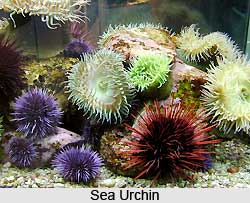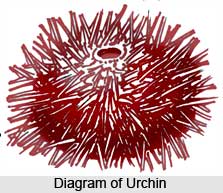 Sea Urchins are perhaps the most capricious fantastic of all echinoderms. They look like prickly balls or small rolled-up hedgehogs. Their size varies from four to twenty five centimetres. They are widely distributed in all shallow and coastal waters in the cracks and crevices of rock pools or amidst soft seaweeds. The deep-water forms are gregarious, covering large areas of the bottom. In appearance a sea urchin is very different from an armed starfish; yet it has the same fundamental structure. Especially it is a starfish and its globular form is the result of its five radial arms having bent upwards and united along their margins and tips.
Sea Urchins are perhaps the most capricious fantastic of all echinoderms. They look like prickly balls or small rolled-up hedgehogs. Their size varies from four to twenty five centimetres. They are widely distributed in all shallow and coastal waters in the cracks and crevices of rock pools or amidst soft seaweeds. The deep-water forms are gregarious, covering large areas of the bottom. In appearance a sea urchin is very different from an armed starfish; yet it has the same fundamental structure. Especially it is a starfish and its globular form is the result of its five radial arms having bent upwards and united along their margins and tips.
 In starfish the skeletal plates are only loosely connected by fibrous tissues but in a sea-urchin the plates are fused to form a hard shell enclosing all the soft parts of the animal including the tube-feet. The mouth however is uncovered. In life the plates are covered with slime outside and within and also between each plate. In a growing urchin these plates are continually thickened by a deposit of fresh limy matter formed by the action of slime and sea water. Additional plates are also added where the tips of the arms converge. Radiating upwards from the mouth along the arms are five bands of small holes through which the tube-feet can project. The pincers (pedicellarias) in a sea-urchin are most specialized than those of starfish in that they are stalked and have three jaws. The spines covering the entire body are brittle, long, sharp and movable. They aid the tube-feet in locomotion. It is a sight to see a sea-urchin moving on the tips of its spines, putting forth here and there its whiter elastic tube-feet. When some of the tube-feet shoot and touch the ground, those already in contact with the ground are pulled back. In a short time the protruded ones are withdrawn and the retracted ones projected and through this operation of the tube-feet coming out and going in the animal progresses. The enemies of sea-urchins are large fishes.
In starfish the skeletal plates are only loosely connected by fibrous tissues but in a sea-urchin the plates are fused to form a hard shell enclosing all the soft parts of the animal including the tube-feet. The mouth however is uncovered. In life the plates are covered with slime outside and within and also between each plate. In a growing urchin these plates are continually thickened by a deposit of fresh limy matter formed by the action of slime and sea water. Additional plates are also added where the tips of the arms converge. Radiating upwards from the mouth along the arms are five bands of small holes through which the tube-feet can project. The pincers (pedicellarias) in a sea-urchin are most specialized than those of starfish in that they are stalked and have three jaws. The spines covering the entire body are brittle, long, sharp and movable. They aid the tube-feet in locomotion. It is a sight to see a sea-urchin moving on the tips of its spines, putting forth here and there its whiter elastic tube-feet. When some of the tube-feet shoot and touch the ground, those already in contact with the ground are pulled back. In a short time the protruded ones are withdrawn and the retracted ones projected and through this operation of the tube-feet coming out and going in the animal progresses. The enemies of sea-urchins are large fishes.
There are three types of sea-urchins - the true Sea-urchins which are globular, Cake-urchins with almost circular and flattened bodies, and Heart-urchins shaped like a heart. Sea-urchins are coloured differently in purple, green, ochre and blue. Under each type there are several interesting forms along Indian coasts.
Temnopleura toreumaticus is commonly found on Chennai beach. It is slightly conical in shape about four centimetres in diameter. The shell is greyish brown covered with somewhat long and reddish spines banded white. Stomopneustes variolaris is a big urchin with very long and thick spines mounted on tubercles and coloured purple. They are found at extreme low tide clinging to rocks. Among Cake-urchins several species of the genus Echinodiscus are common. They are recognised by the pair of oblique slits continuous with or near to the hind margin of the shell. One of the commonest Indian Heart-urchins is Echinolampas, having a slanting appearance and prominent petal markings.






































